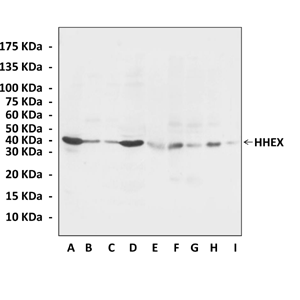Anti-HHEX/PRH: Rabbit HHEX/PRH Anitbody |
 |
BACKGROUND The PRH (proline-rich homeodomain) protein, also known as the Hex (haematopoietically expressed homeobox) protein (also termed Hhex or HHEX) is a member of the homeobox gene-encoded protein family, which functions as both a transcriptional repressor and activator. HHEX/PRH regulates both cell differentiation and cell proliferation. It is critical for many processes in embryonic development including embryonic patterning, formation of head, forebrain, thyroid and liver and heart and development of the vasculature. Moreover, It was shown that HHEX/PRH is involved in Wnt signaling, a fundamental pathway for cell growth and development. HHEX/PRH is able to block the SOX13-dependent repression of Wnt/TCF activity by displacing SOX13 from the SOX13•TCF1 complex. The interaction between HHEX/PRH and SOX13 may contribute to control Wnt/TCF signaling in the early embryo.1 HHEX/PRH also has a number of functions in the adult including that of a regulator of haematopoiesis. It was demonstrated that HHEX/PRH is a critical regulator of hematopoietic development and is required for the maturation and proliferation of the earliest definitive hematopoietic progenitors. Exogenous expression of HHEX/PRH inhibits cell proliferation and cellular transformation of haematopoietic cells of myeloid lineage. However, HHEX/PRH can also function as an oncoprotein in haematopoietic cells of T-cell lineage. Interestingly, HHEX/PRH can both activate and repress transcription and regulate mRNA transport making HHEX/PRH a member of a select group of proteins that control gene expression at the transcriptional and translational levels. Some of the genes that HHEX/PRH regulates encode proteins that are involved in control of the cell cycle or in growth factor signalling pathways. In addition HHEX/PRH makes direct protein–protein interactions with many cellular proteins that influence the cell cycle. Recent biophysical analysis of the HHEX/PRH protein has shown that it forms homo-oligomeric complexes in vivo and in vitro and that the proline-rich region of HHEX/PRH forms a novel dimerization interface.2
The HHEX/PRH protein consists of three regions: a proline-rich N-terminal domain, a central homeodomain and an acidic C-terminal domain. The proline-rich N-terminal domain of PRH can make multiple protein–protein interactions and binds to several proteins including PML (promyelocytic leukaemic), eIF-4E, proteosome subunit HC8 and members of the Groucho/TLE family of co-repressor proteins. The N-terminal domain of HHEX/PRH is required for oligomerization and transcriptional repression and can influence the DNA-binding activity of the HHEX/PRH homeodomain. As well as binding to DNA, the HHEX/PRH homeodomain is important in HHEX/PRH oligomerization and forms protein–protein interactions with other transcription factors. The C-terminal domain of HHEX/PRH is rich in acidic residues but appears to play no role in repression; however, both the homeodomain and C-terminal domain are reported to play a role in transcription activation by HHEX/PRH. It was demonstrated that HHEX/PRH interacts with protein kinase CK2β and CK2 phosphorylates HHEX/PRH in vitro and in cells and that phosphorylation inhibits the DNA-binding activity of HHEX/PRH. Two amino acids within this the homeodomain that are phosphorylated by CK2: Ser163 and Ser177.3 Decreased HHEX/PRH expression and loss of nuclear localization of HHEX/PRH is implicated in a number of human myeloid leukaemias. In addition, a chromosomal translocation resulting in a HHEX/PRH fusion protein that can activate transcription and has trans-dominant-negative activity over wild-type HHEX/PRH has been shown to be a causative agent in acute myeloid leukaemia. Moreover, HHEX/PRH gene polymorphisms are associated with type 2 diabetes.4
The HHEX/PRH protein consists of three regions: a proline-rich N-terminal domain, a central homeodomain and an acidic C-terminal domain. The proline-rich N-terminal domain of PRH can make multiple protein–protein interactions and binds to several proteins including PML (promyelocytic leukaemic), eIF-4E, proteosome subunit HC8 and members of the Groucho/TLE family of co-repressor proteins. The N-terminal domain of HHEX/PRH is required for oligomerization and transcriptional repression and can influence the DNA-binding activity of the HHEX/PRH homeodomain. As well as binding to DNA, the HHEX/PRH homeodomain is important in HHEX/PRH oligomerization and forms protein–protein interactions with other transcription factors. The C-terminal domain of HHEX/PRH is rich in acidic residues but appears to play no role in repression; however, both the homeodomain and C-terminal domain are reported to play a role in transcription activation by HHEX/PRH. It was demonstrated that HHEX/PRH interacts with protein kinase CK2β and CK2 phosphorylates HHEX/PRH in vitro and in cells and that phosphorylation inhibits the DNA-binding activity of HHEX/PRH. Two amino acids within this the homeodomain that are phosphorylated by CK2: Ser163 and Ser177.3 Decreased HHEX/PRH expression and loss of nuclear localization of HHEX/PRH is implicated in a number of human myeloid leukaemias. In addition, a chromosomal translocation resulting in a HHEX/PRH fusion protein that can activate transcription and has trans-dominant-negative activity over wild-type HHEX/PRH has been shown to be a causative agent in acute myeloid leukaemia. Moreover, HHEX/PRH gene polymorphisms are associated with type 2 diabetes.4
REFERENCES
1. Marfil, V. et al: J. Biol. Chem. 285:5726-37, 2010
2. Soufi, A. & Jayaraman, P-S.: Biochem. J. 412:399-413, 2008
3. Soufi, A. et al: Nucl. Acids Res. 37:3288-300, 2009
4. van Vliet-Ostaptchouk, J. V. et al: Eur. J. Hum. Genet. 16:652-6, 2008
2. Soufi, A. & Jayaraman, P-S.: Biochem. J. 412:399-413, 2008
3. Soufi, A. et al: Nucl. Acids Res. 37:3288-300, 2009
4. van Vliet-Ostaptchouk, J. V. et al: Eur. J. Hum. Genet. 16:652-6, 2008
Products are for research use only. They are not intended for human, animal, or diagnostic applications.
Параметры
Cat.No.: | CA1326 |
Antigen: | Short peptide from human HHEX/PRH N-terminal sequence. |
Isotype: | Rabbit IgG |
Species & predicted species cross- reactivity ( ): | Human, Mouse, Rat |
Applications & Suggested starting dilutions:* | WB 1:1000 IP n/d IHC 1:50 - 1:200 ICC n/d FACS n/d |
Predicted Molecular Weight of protein: | 40 kDa |
Specificity/Sensitivity: | Detects endogenous levels of HHEX/PRH proteins without cross-reactivity with other related proteins. |
Storage: | Store at -20°C, 4°C for frequent use. Avoid repeated freeze-thaw cycles. |
*Optimal working dilutions must be determined by end user.
Документы
Информация представлена исключительно в ознакомительных целях и ни при каких условиях не является публичной офертой








